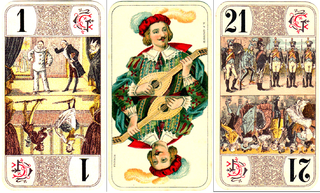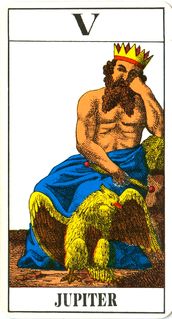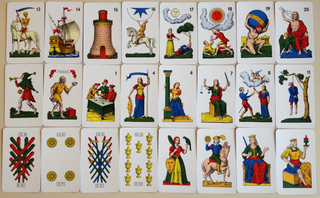 W
WAnimal tarots are a subgenre of tarot decks that were most commonly found in northern Europe, from Belgium to Russia. A theme of animals, real and/or fantastic, replaces the traditional trump scenes found in the Italian-suited Tarot of Besançon. The Sküs plays a musical instrument while the Pagat is represented by Hans Wurst, a carnival stock character who carries his sausage, drink, slap stick, or hat. They constitute the first generation of French-suited tarot patterns. Prior to their introduction, tarot card games were confined to Italy, France, and Switzerland. During the 17th century, the game's popularity in these three countries declined and was forgotten in many regions. The rapid expansion of the game into the Holy Roman Empire and Scandinavia after the appearance of animal tarots may not be a coincidence. In the 19th century, most animal tarots were replaced with tarots that have genre scenes, veduta, opera, architecture, or ethnological motifs on the trumps such as the Industrie und Glück of Austria-Hungary.
 W
WThe Tarot Nouveau, French Tarot Nouveau or Bourgeois Tarot deck is a pattern of tarot cards. As such it differs from those tarot decks used in fortune-telling, such as the Tarot of Marseilles and Rider-Waite decks, in that the Tarot Nouveau is designed solely for playing the various tarot card games for which the 78-card tarot deck was originally devised. In the French language, this deck is often called the tarot à jouer or playing tarot. This usage is distinct from cartomancy and other divinatory purposes, for which the tarot is most commonly known outside Continental Europe. This deck is most commonly found in France, Wallonia, Romandy, and Québec for French Tarot; and Denmark for Danish Tarok.
 W
WIndustrie und Glück is a pattern of French suited playing cards used to play tarock. The name originates from an inscription found on the second trump card. This deck was developed during the nineteenth century in the Austro-Hungarian Empire. The earliest known examples were made in Vienna in 1815. After the collapse of the empire in World War I, it remained the most widely used tarot deck in Central Europe and can be found throughout the former parts of the empire.
 W
WThe Swiss 1JJ Tarot deck is a 78-card deck used for the tarot card games Troccas and Troggu and also for divination.
 W
WThe Tarocco Bolognese is a tarot deck found in Bologna and is used to play tarocchini. It is a 62 card Italian suited deck which influenced the development of the Tarocco Siciliano and the obsolete Minchiate deck.
 W
WThe Tarocco Siciliano is a tarot deck found in Sicily and is used to play Sicilian tarocchi. It is one of the three traditional Latin-suited tarot decks still used for games in Italy, the others being the more prevalent Tarocco Piemontese and the Tarocco Bolognese. The deck was heavily influenced by the Tarocco Bolognese and the Minchiate. It is also the only surviving tarot deck to use the Portuguese variation of the Latin suits of cups, coins, swords, and clubs which died out in the late 19th and early 20th centuries.
 W
WThe Tarot de Besançon, also called the Besançon Tarot or Swiss Tarot, describes a type of Tarot pack that was derived from the older forms of the Marseille type, but which portrays characteristic differences.
 W
WThe Tarot Nouveau, French Tarot Nouveau or Bourgeois Tarot deck is a pattern of tarot cards. As such it differs from those tarot decks used in fortune-telling, such as the Tarot of Marseilles and Rider-Waite decks, in that the Tarot Nouveau is designed solely for playing the various tarot card games for which the 78-card tarot deck was originally devised. In the French language, this deck is often called the tarot à jouer or playing tarot. This usage is distinct from cartomancy and other divinatory purposes, for which the tarot is most commonly known outside Continental Europe. This deck is most commonly found in France, Wallonia, Romandy, and Québec for French Tarot; and Denmark for Danish Tarok.
 W
WThe Tarot of Marseilles or Tarot of Marseille, also widely known by the French designation Tarot de Marseille, is one of the standard patterns for the design of tarot cards. It is a pattern from which many subsequent tarot decks derive.
 W
WTrionfi are 15th-century Italian playing cards with allegorical content related to those used in tarocchi games. The general English expression "trump card" and the German "trumpfen" have developed from the Italian "Trionfi". Most cards feature the personification of a place or abstraction.
 W
WThe Visconti-Sforza tarot is used collectively to refer to incomplete sets of approximately 15 decks from the middle of the 15th century, now located in various museums, libraries, and private collections around the world. No complete deck has survived; rather, some collections boast a few face cards, while some consist of a single card. They are the oldest surviving tarot cards and date back to a period when tarot was still called Trionfi cards, and used for everyday playing. They were commissioned by Filippo Maria Visconti, Duke of Milan, and by his successor and son-in-law Francesco Sforza. They had a significant impact on the visual composition, card numbering and interpretation of modern decks.